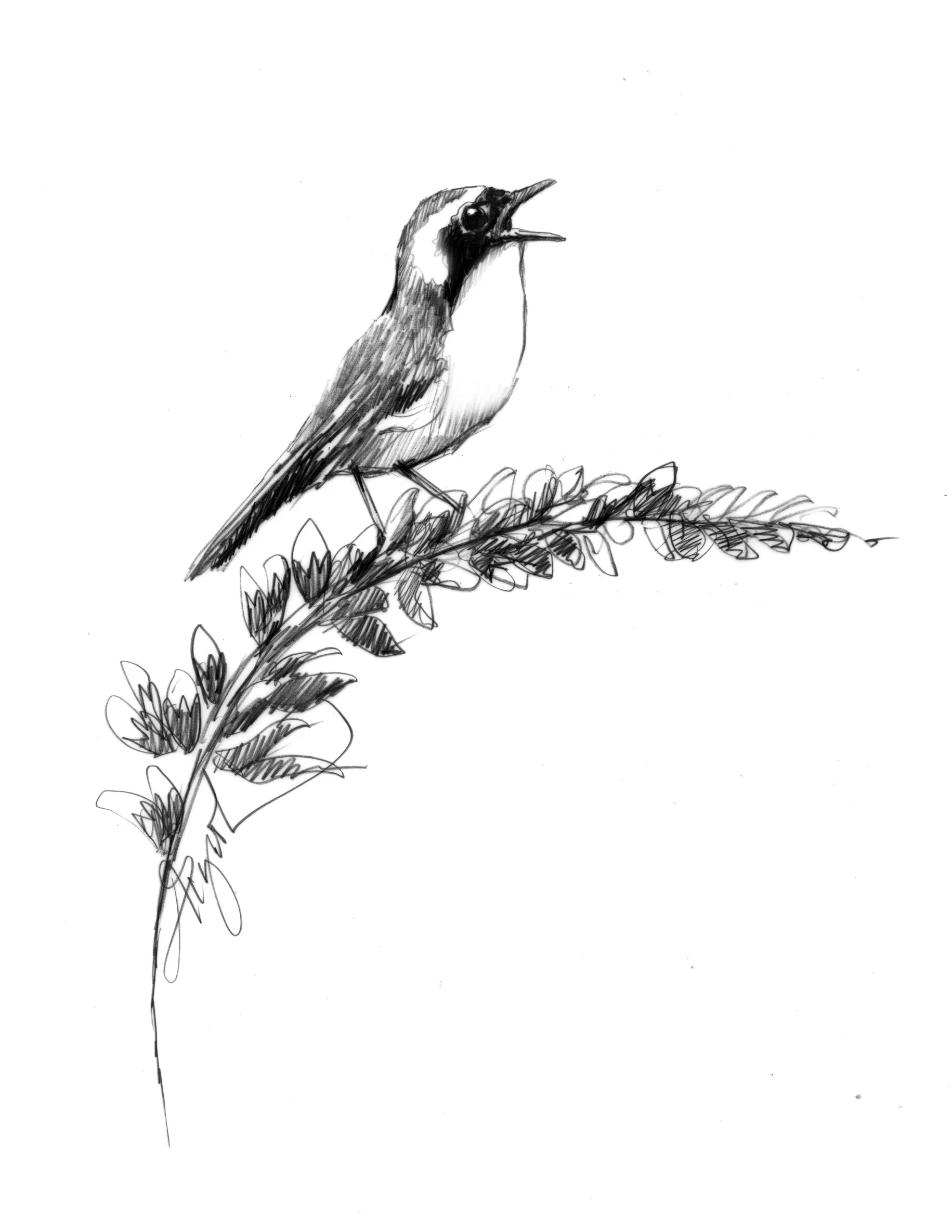The Outside Story: Little masked bandits
May 26, 2022 | By Susan SheaIllustration of a common yellowthroat by Adelaide Murphy Tyrol
“Witchity, witchity, witchity.”
I know that common yellowthroats have returned to my neighborhood in spring when I hear that distinctive song. With luck, I’ll glimpse the striking male as he darts about the shrubbery.
The common yellowthroat is one of North America’s most abundant warblers, nesting across Canada and the United States, including Alaska. Male yellowthroats return to the breeding grounds before females and begin defending territories.
This small warbler is easy to identify by its olive-green back and the bright yellow coloring of its throat and under-tail coverts. The male has a black facial mask bordered on top by a white band, making him look like a bandit. The female is browner and lacks a facial mask, but also has a yellow throat.
Ornithologists believe the black facial mask and the male’s yellow bib may play a role in attracting females. Separate studies led by Kevin Thusius and Nicholas Sly, both of the University of Wisconsin, found that female yellowthroats preferred males with larger black masks as mates, and those males sired more young. Another study in New York state, led by Corey Freeman-Gallant, determined that females in that area preferred males with larger yellow bibs. Though these plumage ornaments are produced by different pigments, both are linked with genes that may also influence male health attributes, including immunity.
Once the female chooses a male, he follows her closely until she is ready to mate. Her mating calls and display may attract other males, however, and both males and females may breed outside the pair.
Yellowthroats breed in open areas, especially wetlands, with dense, low vegetation, such as grasslands, marshes, shrub swamps, and stream sides. Northern breeders migrate south for the winter to the southern U.S., Mexico, Central America, and the Caribbean. Yellowthroats feed on a wide variety of spiders, as well as insects and insect larvae, including dragonflies, beetles, caterpillars, and moths, gleaning them off vegetation or flying from a perch to snatch them from the air.
These warblers nest on or close to the ground, attaching their nests to clumps of grass, reeds, or bushes. The female weaves a loose outer layer of dry grasses, dead leaves, grapevine bark, and ferns, and lines the inner cup with fine grasses, bark fibers, and hairs. The nest is well concealed, and sometimes partially roofed over. The female lays a clutch of three to five white or cream eggs, speckled with brown, black, or gray.
Brown-headed cowbirds, known nest parasites, often lay their eggs in yellowthroat nests. In some instances, the yellowthroat pair raises a baby cowbird as one of their own (what the female cowbird aims to achieve). Other times, yellowthroats abandon their nest or build a second or even third nest over the strange egg(s).
The female yellowthroat incubates her eggs for about 12 days, while the male sings to maintain their territory and delivers food to her.
The young are born naked and with eyes sealed shut, but soon open their mouths to beg for food. They grow rapidly on a diet of insect larvae and soft-bodied adult insects provided frequently by both parents, and within days, the nestlings’ eyes open and they develop feathers. The parents keep the nest clean by removing eggshells and fecal sacs.
By their eighth day of life, young yellowthroats are usually ready to fledge, or leave the nest. After a few days of hopping around the ground and low vegetation, the fledglings learn to fly, although both parents continue to feed and care for the young birds until they are at least four weeks old. Once the juveniles become independent, the parents may raise a second brood.
Though yellowthroats are still numerous, their population declined 38 percent between 1966 and 2014, according to the North American Breeding Bird Survey. Habitat loss was likely the largest contributor to this decline. These birds are also affected by water pollution that degrades the wetlands where they nest and lack of insect food due to pesticide use.
Since their territories can be as small as a half-acre, backyards in rural areas can provide suitable habitat for yellowthroats if there is tall grass or dense shrubs.
Listen for the unmistakable call of the yellowthroat this spring, and you may be treated to the sight of this colorful warbler.
Susan Shea is a naturalist, writer, and conservationist based in Vermont. The Outside Story is assigned and edited by Northern Woodlands magazine and sponsored by the Wellborn Ecology Fund of the New Hampshire Charitable Foundation.

